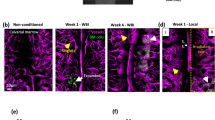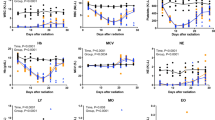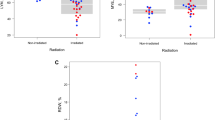Abstract
THE continued use of bone marrow transplantation1 in disease states and after accidental or therapeutic exposure to radiation has led to an increasing number of in vitro and in vivo studies of the viability of human and animal bone marrow. Among the more recent methods for quantitative studies of animal marrow is the mouse spleen colony technique. Till and McCulloch2 were the first to show that syngeneic mouse bone marrow, when injected into animals which had received a lethal dose of radiation, will cause the formation of macroscopic spleen nodules in a number directly proportional to the number of injected cells. These discrete colonies are assumed to arise from single marrow cells, which are generally described as colony forming units (CFU) and are often equated with the marrow stem cell. This method of studying colony formation has been used to study stem cell kinetics3, cellular radiation sensitivity2, immune reactions4, anaemic mutants5, and various phases of haematopoietic repopulation in the normal and post-irradiation states.
This is a preview of subscription content, access via your institution
Access options
Subscribe to this journal
Receive 51 print issues and online access
$199.00 per year
only $3.90 per issue
Buy this article
- Purchase on SpringerLink
- Instant access to full article PDF
Prices may be subject to local taxes which are calculated during checkout
Similar content being viewed by others
References
Pegg, D. E., in Bone Marrow Transplantation (Lloyd-Luke Ltd, London, 1966).
Till, J. E., and McCulloch, E. A., Radiat. Res., 14, 213 (1961).
Till, J. E., McCulloch, E. A., and Siminovitch, L., Proc. US Nat. Acad. Sci., 51, 29 (1964).
Trentin, J. J., and Fahlberg, W. J., in Conceptual Advances in Immunology and Oncology, 66 (Harper (Hoeber), New York, 1963).
McCulloch, E. A., Siminovitch, L., and Till, J. E., Science, 144, 844 (1964).
Puck, T. T., Cieciura, S. J., and Robinson, A., J. Exp. Med., 108, 945 (1958).
Stoner, R. D., and Bond, V. P., Exp. Hematol., 91 (2), 185 (1963).
Curry, J. L., and Trentin, J. J., Dev. Biol., 15 (5), 395 (1967).
Lewis, J. P., O'Grady, Lois F., and Trobaugh, jun., F. E., Exp. Hematol., 12, 33 (1967).
Wolf, N. S., and Trentin, J .J., J. Exp. Med., 127, (1) 205 (1968).
Author information
Authors and Affiliations
Rights and permissions
About this article
Cite this article
CARSTEN, A., BOND, V. Viability of Stored Bone Marrow Colony Forming Units. Nature 219, 1082 (1968). https://doi.org/10.1038/2191082a0
Received:
Issue date:
DOI: https://doi.org/10.1038/2191082a0



